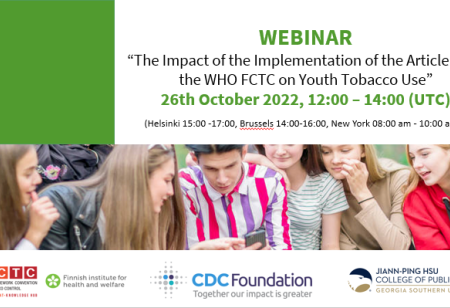
Monitoring and research on youth e-cigarette use informs preventive policies - 23 January 2023

Monitoring prevalence of e-cigarette and new nicotine product use among youth is of utmost importance as increased popularity of these products places a new generation at risk of nicotine addiction. Proactive action is needed to improve surveillance and promote research on use of e-cigarettes and novel nicotine products to ensure development, adoption, and implementation of preventive measures.
On average one in ten adolescents uses e-cigarettes worldwide; however, there are wide variations in prevalence of e-cigarettes users across countries. Tobacco and e-cigarette companies are using diverse channels to promote these products to youth. New products are gaining visibility at points of sales, via television, movies, streaming channels and online media such as Instagram and TikTok. How do we tackle the growing challenges?
By 2021, 182 countries have ratified the World Health Organizations’ Framework Convention on Tobacco Control (WHO FCTC). The goal of the WHO FCTC is to implement evidence-based measures to prevent and reduce tobacco use. With support from the CDC Foundation, the WHO FCTC Knowledge Hub on Surveillance has been conducting a study on the implementation of the WHO FCTC required or recommended tobacco advertising bans and youth e-cigarette and tobacco use. In this project, both country-level data provided by the Parties of the WHO FCTC as part of the biennial implementation reporting, and individual-level data from the Global Youth Tobacco Survey (GYTS) have been utilized. Initial results were presented in a webinar organized on 26 October 2022 (program and the webinar recording are available here). The final results will be published as two open-access articles and a policy brief during 2023.
Combining country-level data with youth individual data has allowed for studying the associations by taking into account not only the implemented policies reported by the WHO FCTC focal points, but also country income level together with youth prevalence and advertising exposure measures as well as youth socioeconomic indicators. Key lessons learnt in the project include the need for more countries to include e-cigarette use into their national surveillance systems for youth, in order to conduct more cross-country studies assessing the policy and prevalence associations. Further, there is need to develop key surveillance instruments to incorporate measures that capture youth exposure to tobacco and related product promotion in newer channels such as social media. And last, there is need to consider developing the policy level data so that the scope of the different policies in terms of the different tobacco and nicotine products would be possible to assess.
In general, there is still a need to improve the implementation of Article 13 of the WHO FCTC, as highlighted by the Global Progress Reports of the implementation of the WHO FCTC. Enhanced and continuous efforts are needed to protect youth from the promotion of the new tobacco and nicotine products by the tobacco industry and vested interests.
About the author:
Tuija Ylitörmänen, RN, PhD
Senior Researcher, Finnish Institute for Health and Welfare
Tuija has a working history in health promotion. She received her PhD degree from the Faculty of Health Science in the University of Eastern Finland. Currently, she works as a senior researcher in this collaborative research project that addresses the implementation of tobacco advertising bans and youth tobacco use. The key team members of the project include Hanna Ollila, a Senior Specialist at the Finnish Institute for Health and Welfare (THL), Yelena Tarasenko, Professor at Department of Biostatistics, Epidemiology, and Environmental Health Sciences, Jiann-Ping Hsu College of Public Health, Otto Ruokolainen, a Senior Specialist at the Finnish Institute for Health and Welfare (THL).





